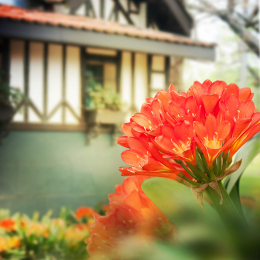A burst of sun is what clivias offer when planted and cared for the right way. Grow this plant in your garden and enjoy its beauty.

Just as its cousin, the amaryllis, clivia bears vibrant colored flowers on green strapy leaves. Native to southern Africa, clivia is a genus of monocot flowering plants belonging to the family
Amaryllidaceae. It is also known by other names such as Kaffir lily or bush lily. One of the primary reasons that these are favored as houseplants is their capability to withstand unsuitable climatic conditions and yet thrive.
Clivia flowers are very similar in appearance to the amaryllis flowers, except that they are smaller and the cluster has more flowers in it. A rich bulbous flora, clivia has many societies dedicated to giving information about its growth habits and care. Its leaves are a bright green and shoot directly from the bulb in the soil. The plant may grow about 2-3 feet tall. Leaves arch gracefully as they are produced in an alternate sequence. Tall flower stalks shoot straight from the base point, and a healthy matured clivia will have minimum 3-4 shoots. Depending upon the variety, clivias may shoot a 20-inch flowering stem stalk close to the center of the plant, nestled among the rich green foliage. The flower stalks have no leaves. These flowers come in colors of red, orange, yellow, and some new pastel shades as well. Red-colored berries follow the flowers.
How to Grow
Clivia is a summer plant, but can be grown successfully in winters too. It is preferably grown as a houseplant and is suitable for container gardening, as the plant only flowers when it reaches maturity. Most varieties bloom in spring.
- Planting:
This plant can be propagated by dividing clumps or rhizomes, or through seeds. Beneath the flesh of the round red berries borne by the plant, a seed pod is present. Sow them in a good potting mix, by just pressing them down halfway. Moisten the sowing medium. Once the seeds develop roots and sprouts, add more soil to cover the seed. Seedlings have a very slow growth rate. About 2-8 leaves is all it will develop in the first two years. Thus, starting this plant from seeds requires plenty of patience. Hence, division of clumps in spring is considered a better option. It can be easily planted in ground under large trees.
Plant the clumps in a gritty medium, with a peat-based soil-less potting mix, and some sand and gravel. They prefer soil with a pH balance between 5 and 6. Plant clumps in a container that will allow it plenty of space for growth. Clivias prefer being root bound, so moving or replanting every year is not a necessity to promote their growth. This plant flowers after it reaches maturity, that is after three or four years.
- Plant Care:
Water clivia indoors or outdoors only when the top soil becomes dry, as the plant will not survive excess watering. Position your plant in shade, especially in places where it is difficult to grow any other plant. They prefer dry environment and need to be protected from frost. Never leave the plant in full sun, as the delicate flowers and leaves will burn out. Feed with a liquid fertilizer during the summer months, but sparingly. Watch out for slugs, caterpillars, and snails that have quite a taste for clivia leaves, as untreated pests eat the base away, killing the plant.
Although clivias will only flower upon maturity, that would be a good couple of years from planting its clumps. So you will have to wait to enjoy the glory of its beautiful flowers.






 Just as its cousin, the amaryllis, clivia bears vibrant colored flowers on green strapy leaves. Native to southern Africa, clivia is a genus of monocot flowering plants belonging to the family Amaryllidaceae. It is also known by other names such as Kaffir lily or bush lily. One of the primary reasons that these are favored as houseplants is their capability to withstand unsuitable climatic conditions and yet thrive.
Just as its cousin, the amaryllis, clivia bears vibrant colored flowers on green strapy leaves. Native to southern Africa, clivia is a genus of monocot flowering plants belonging to the family Amaryllidaceae. It is also known by other names such as Kaffir lily or bush lily. One of the primary reasons that these are favored as houseplants is their capability to withstand unsuitable climatic conditions and yet thrive.